From Books to Digital Worlds: The Beijing Library’s Role in Shaping a Community-Centered Future
30 November 2024
A Cultural Landmark: Connecting the Past, Present, and Community
In 2023, the Beijing Library opened its doors in Tongzhou as a branch of the Capital Library of China (CLCN). Continuing CLCN’s legacy of providing high-quality cultural services to the public since 1913, the Beijing Library serves as a multifunctional community hub for all. Offering educational programs, cultural events, and a wealth of information resources, the library fosters connections—linking readers to resources, encouraging interaction among patrons, and strengthening ties between individuals and the broader society.
With its stunning design, comfortable spaces, rich resources, and advanced technology, the library quickly became a cultural destination for the community. In its first nine months, the library welcomed 3.3 million visitors, including 20,000 from abroad. Half of Tongzhou’s residents are now patrons, with visitors staying for an average of 2.5 hours. On weekends, the library attracts around 20,000 visitors daily, offering a respite from fast-paced city life.
Architecture: Connecting People, Books, and Nature
The Beijing Library, co-designed by Snøhetta (Norway) and ECADI (China), is nestled within a large park in Tongzhou. Historically, Tongzhou was a crucial transportation hub due to the Beijing-Hangzhou Grand Canal. The architecture of the Beijing Library reflects this rich heritage. The central hall features blue terrazzo flooring designed to resemble a river, symbolising the Tonghui River flowing through the area. The roof is adorned with ginkgo leaf-shaped panels, a nod to the ancient tree species native to China. Its open layout includes two 16-meter-high mountain-like structures leading to terraced spaces known as “Forest Hills”, which serve as primary reading and activity areas. The space between these terraces forms a valley-like passage, symbolising the historical significance of the Grand Canal and Tongzhou’s cultural accumulation.

Praised as a model of nature-integrated design, the library won the prestigious “China Construction Engineering Steel Structure Gold Award” in 2021. Visitors experience a unique blend of nature and books, with opportunities to climb to a summit overlooking the “hills” of books and the surrounding landscape. Furniture and equipment, designed to harmonise with natural elements, include desks and chairs of varying heights and firmness. Modern features, such as charging points and information screens, accommodate the needs of today’s readers.
The Beijing Library redefines the 21st-century library, forming emotional connections between people, books, and nature. It offers a lasting space for learning, social interaction, and knowledge-sharing in a once-underdeveloped suburban area, transforming Tongzhou into a vibrant cultural hub.
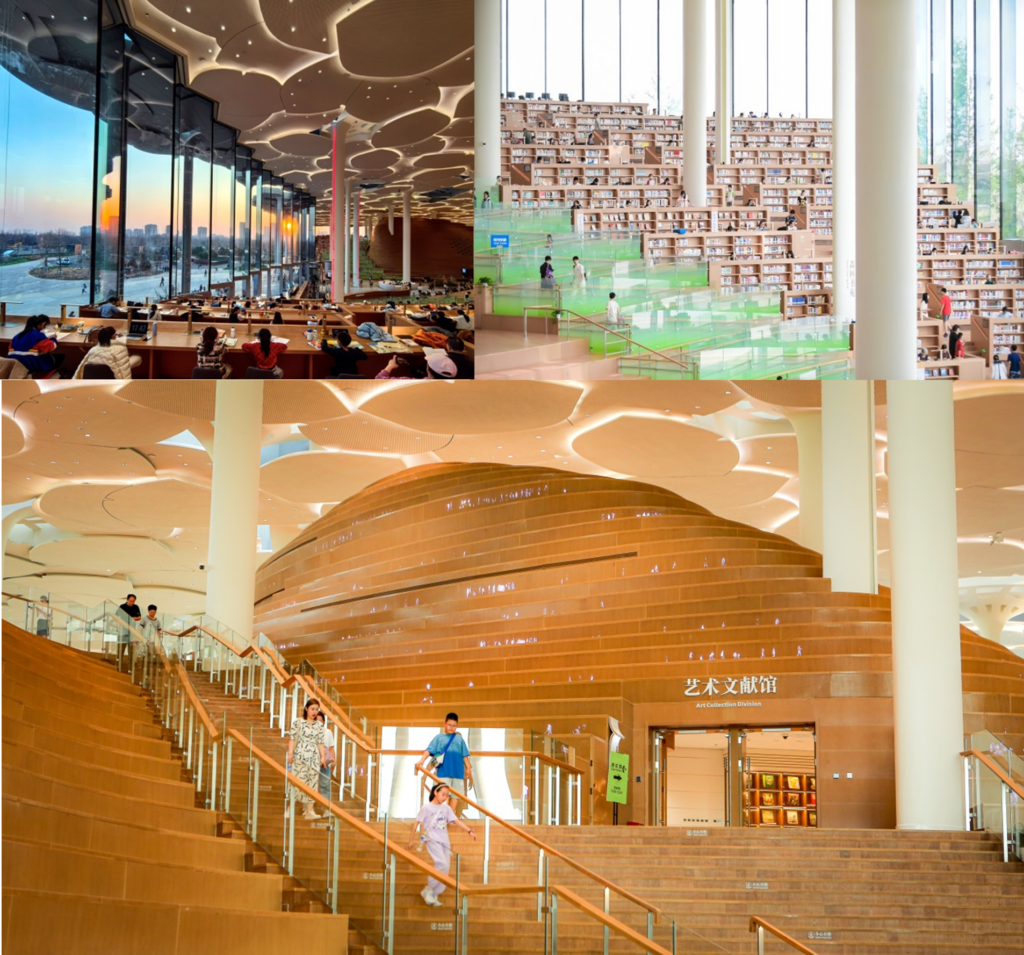
More Than a Library: A Multidimensional Cultural Space
Beijing Library is not just a library—it is a museum, concert hall, art centre, and technology hub. The basement exhibition hall showcases an exhibit on old Beijing, while the first-floor lecture hall, with its 500 seats, hosts symphony concerts and academic forums. Visitors to the café can enjoy drinks made by a robotic barista while participating in calligraphy workshops. The terraced Forest Hills, adorned with art installations, create a unique blend of art and learning.
Designed for flexibility, the library’s spaces adapt to various purposes. The terraced hills serve as seating, shelving, and gathering spaces, encouraging informal social interactions and collaborative study sessions. The library’s flexible design fosters personal growth, discovery, and lifelong learning.
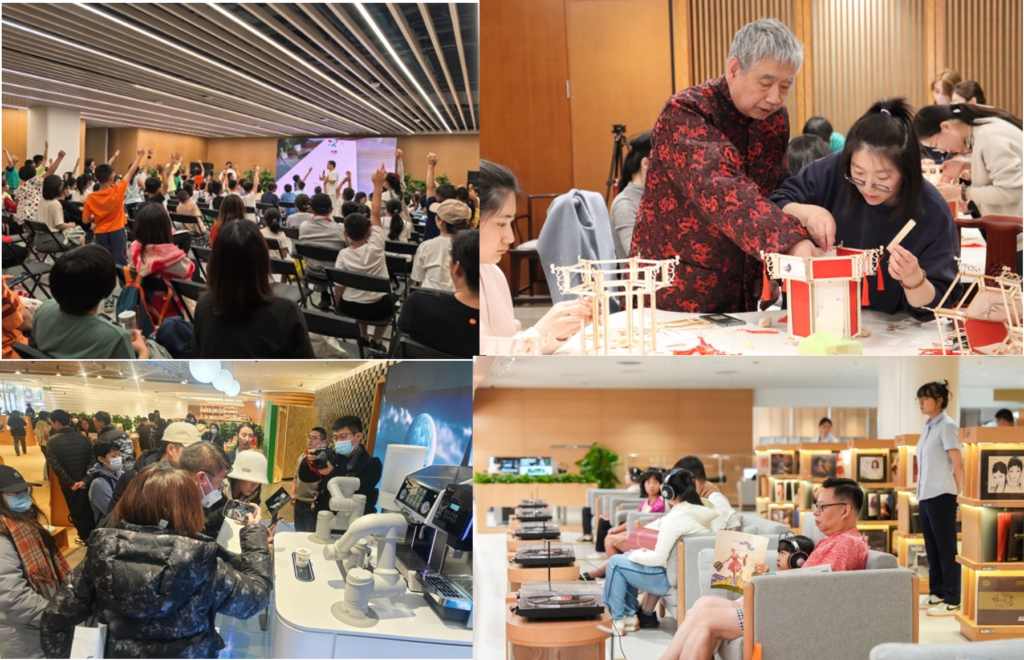
Sustainability in Action: Building a Greener Future
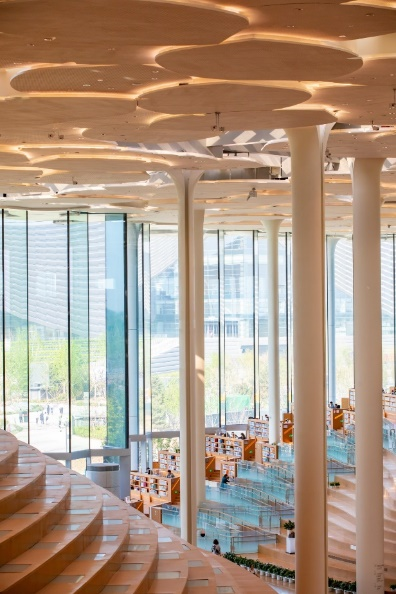 Libraries play a crucial role in promoting sustainable development. The Beijing Library demonstrates its commitment to sustainability through its green design and practices. Awarded China’s Green Building Evaluation Label (GBEL) Three Star, the highest green building standard, the library incorporates energy-efficient technologies, modular components, and a rationalised structural grid to minimize waste and improve energy efficiency.
Libraries play a crucial role in promoting sustainable development. The Beijing Library demonstrates its commitment to sustainability through its green design and practices. Awarded China’s Green Building Evaluation Label (GBEL) Three Star, the highest green building standard, the library incorporates energy-efficient technologies, modular components, and a rationalised structural grid to minimize waste and improve energy efficiency.
The ginkgo tree columns, arranged on a 9 by 9-meter grid, integrate climate control, lighting, and acoustics, while collecting rainwater for irrigation. Roof overhangs reduce solar gain, while integrated photovoltaic elements generate renewable energy. The library has fully implemented green office routines, including paperless operations, waste sorting, and intelligent lighting controls. These efforts transform the library into a sustainable “third space,” supporting urban development while caring for the environment.
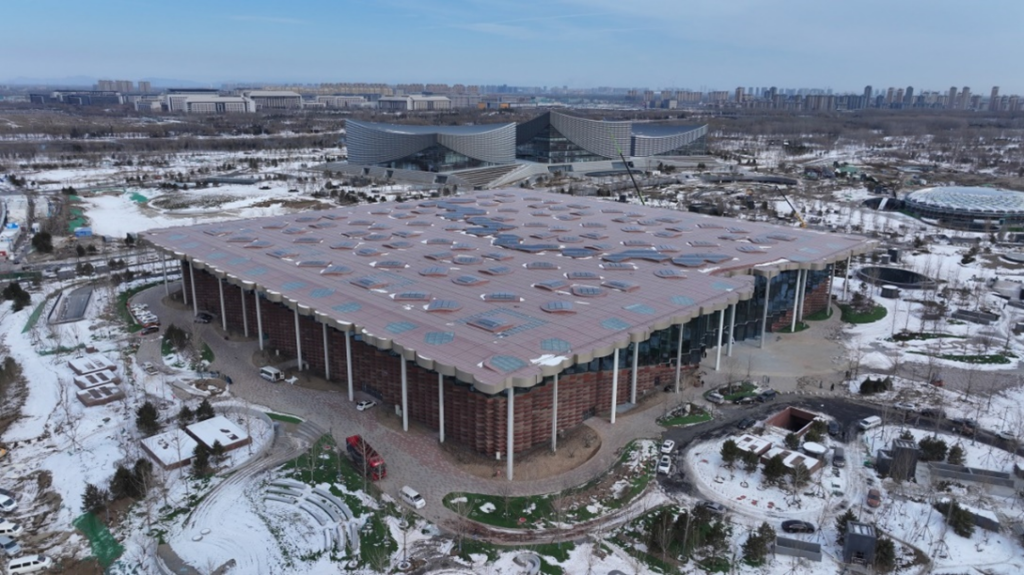
A Library for All: Inspiring Learning and Well-being
On its 88th day, the Beijing Library welcomed its one-millionth visitor. A father shared his experience: “After helping my daughter pick books, I’m visiting the Metaverse Experience Hall while my wife enjoys a piano concert. The library offers something for everyone, and I genuinely love spending time here.”
This family’s experience reflects the library’s vision of creating a space for all to learn and grow. With 8 million books and 800TB of online resources, the library offers reliable information and inspiring learning opportunities. Collaborations with universities and businesses enrich the community, while 24-hour spaces cater to night readers.
Beyond academic support, the library promotes overall well-being. In the children’s area, an interactive “Emotion Recogniser” helps kids understand their emotions through physical data analysis. The library aims to ensure that every visitor leaves with something valuable, whether it’s knowledge, an experience, or a new connection.

Technology-Driven Experiences: Personalising the Library for Everyone
Advanced technologies are integrated into every aspect of the Beijing Library’s services, offering a personalised experience. Internet of Things technology monitors building conditions in real-time, adjusting temperature and lighting for comfort and safety. Digital resources, borrowing, and activity reservations are easily accessible through both PC and mobile platforms. Robotic librarians navigate the Forest Hills, delivering personalised book recommendations and providing services to visitors in the park.
For patrons over 60, smart-tops at desks automatically switch to larger fonts and offer senior-friendly features, such as book delivery services within the library to the patrons via robotic librarians. The Metaverse Experience Hall and digital twin technology extend the library’s reach into the virtual world, engaging visitors in immersive experiences. By embracing new technologies, the Beijing Library stimulates creativity and personal growth while shaping the future of library services.
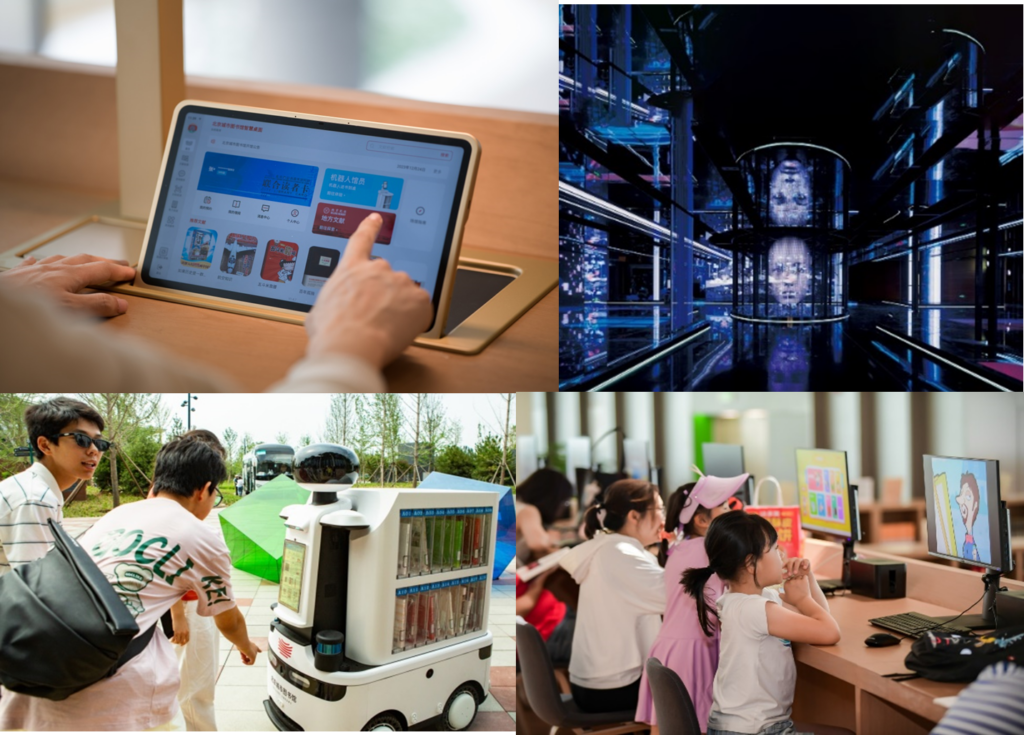
Empowering Communities: A Commitment to Learning and Equity
The Beijing Library integrates the UN Sustainable Development Goals (SDGs) and IFLA strategies into its services. Emphasising quality education and lifelong learning, the library provides free access to books, activities, and resources. The ” Cradle Gift” program offers newborns their first library card and a list of recommended books for new mothers. An online learning platform offers free access to vocational courses and award-winning books, accessible through smart devices.
The library promotes social equity by providing professional services to support career development. As a certified legal education base, it offers free legal consultations. Digital literacy programs help bridge the digital divide, ensuring that all community members, regardless of background, have access to essential skills and technologies. Through these efforts, the Beijing Library creates an inclusive space that supports lifelong learning and community growth.
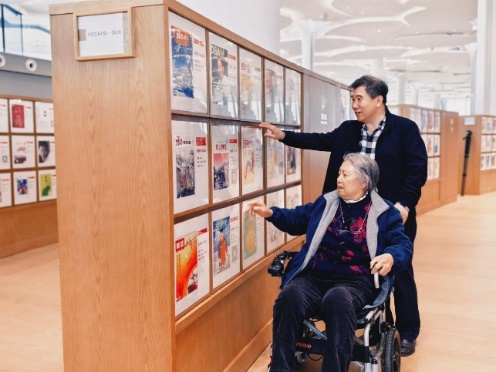
Contributed by Beijing Library